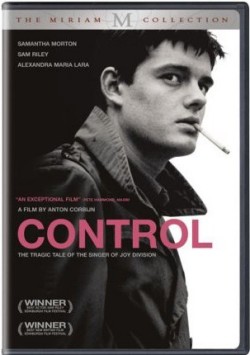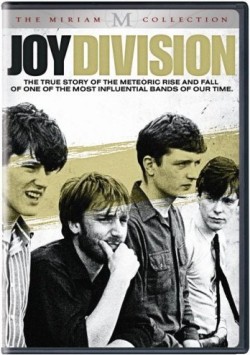 |
 |
Hey everyone, please give a warm bumpershine welcome to cineaste, screenwriter, producer, director, and now film critic, David Winkfield, who was kind enough to share his thoughts on these two new films about influential UK rock band, Joy Division. We love movies here at bumpershine, so hopefully will be seeing more of Dave around these parts in the weeks and months to come. -ed.
CONTROL by Anton Corbijn and JOY DIVISION by Grant Gee
By David Winkfield
Control and Joy Division are two recent releases from The Miriam Collection a relatively new “premiere” label from the Weinstein Company. Although these two films do not require tandem viewing they both are legitimate forms of entertainment and historical documents of the band Joy Division. Grant Gee, notable documentarian and director of Radiohead’s 1998 “˜Meeting People is Easy’, examines the origin of the band by interviewing the three surviving members and those who participated in the rise to an almost cult status before the tragic suicide of lead singer Ian Curtis, who died at the age of 23. There seems to be a significant piece of the puzzle missing from the documentary though. The teen bride of Ian, Deborah Curtis, never makes an appearance, potentially the one person who knew him best. Perhaps she declined to participate because of the inclusion of Ian’s longtime girlfriend, Annik Honore, the woman that ultimately dissolved their marriage. This is only speculation on my part and cannot be validated either way but you get a sense as a viewer that something is missing. This is where Control confirmed my speculations.
Control is based upon the autobiography of Deborah Curtis “Touching from a Distance”. Anton Corbijn, long time photographer and music video director makes the leap to feature film with Control and directs the most even handed “˜Biopic’ I have ever seen. Rock films are typically laden with clichés and you may find Corbijn flirting on the edges but he never commits to an easy formula. At times Control feels like a documentary and this is due to the nuanced performances. Samantha Morton plays Deborah Curtis, which could have easily plummeted to the depths of “˜The Woman Scorn’, it avoids total caricature because of her will to stay and her utter devotion to a man that is obviously different than the average bloke, which is originally why she falls in love with him. Newcomer Sam Riley has a difficult task representing a cult icon in Ian Curtis. And despite the ridiculous wig he has to wear the first fifteen minutes of the film he does so with aplomb. The actors who form the band in the film actually demanded to learn the instruments and play the songs live instead of dubbing in slickly produced tracks. This choice leads to a very genuine sense of what we are watching, on screen is somehow more real than fact. Corbijn’s decision to flip to crisp black and white from color filmstock also heightens the films look and locks us into that period of history, Corbijn said this: “The collective memory of Joy Division is a black and white memory… They themselves dressed their music in black and white; the album sleeve is in black and white; Every single photograph you see of the band off stage is black and white. So it seemed natural to me.”
Though each of these films provide an education in the history of Joy Division, I was a little disappointed that neither one dealt with the band’s flirtations with Nazism with any sort of clarity. “˜Joy Division’ is named after a brothel wing in a Nazi concentration camp mentioned in the novella The House of Dolls. Ian Curtis mentions Rudolph Hess’ prison id 31G-350125 in the song Warsaw and in October 1977, Curtis started off a show by saying, “You all forgot Rudolph Hess”. (Rudolph Hess was a prominent figure in Nazi Germany and has become a figurehead in Neo-Nazi rhetoric; he committed suicide in 1987 while still imprisoned.) In an additional interview scene in the Joy Division documentary, bassist, Peter Hook, explained this faux-Nazism as more of a fashion choice borrowing from bands like The Sex Pistols, who regularly wore swastikas symbols as a form of “confrontational dressing”, and had no inherent political motivations. Whatever the case may be these fascinations can probably be attributed to disaffected youth culture in Manchester at that time and will probably be forever shrouded in mystery.
The Grant Gee directed documentary is a gem of a DVD and has an additional 75 minutes of interviews that delve deeper into personal philosophies and behaviors that do not fit into the expositional narrative of the released film. Included also is the “Transmission” music video, which is basically an early television appearance of the band that has mediocre sound quality with Curtis occasionally out of step and off key.
Control has the typical special features that DVD collectors have come to expect; Commentary with director, a “˜Making Of’ featurette, a candid conversation with the director, still gallery, and 2 teaser trailers. The additional 3 music videos are a nice treat; The Transmission video is recycled but Corbijn’s 1988 Joy Division Video “˜Atmosphere’ is included, as well as The Killers music video doing a cover of “˜Shadowplay’.
Both discs are worthy of a purchase or at the very least a rental. I would suggest popping some popcorn, digging in and setting away some time for a double feature. Grant Gee’s documentary first followed by Corbijn’s biopic and you’ll come away with almost everything you’d ever want to know about Joy Division.
Contest: I’m giving away single copies of Control and Joy Division to two random readers who email me at contests@bumpershine.com and tell me which movie starring Steve Coogan also featured the early exploits of the band, Joy Division.
